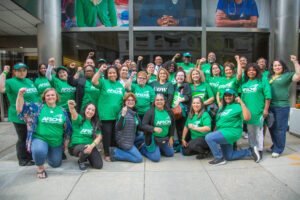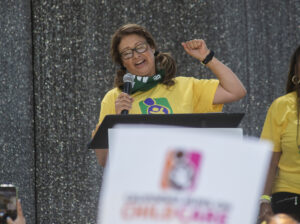
UDW rallies in Washington D.C.
Speaking before a crowd at the Care Can’t Wait rally in Washington, DC, home care provider Sabrina Bishop from San


Speaking before a crowd at the Care Can’t Wait rally in Washington, DC, home care provider Sabrina Bishop from San

March was Women’s History Month, and as a union made up mostly of women, every year we celebrate and uplift

This June, more than 2,000 family child care and home care providers took to the streets of Sacramento to demand

Families of four with incomes of up to $96,300 are eligible for subsidized child care, under new state income limits,

After months of negotiations and a number of vigils, marches and rallies to spur public support, California’s unionized child care providers have reached a new labor deal with the state.

The child care, elected bargaining team is excited to announce that we have reached a tentative agreement on our new,

BY JEANNE KUANG Gabriela Guerrero’s children are all grown and have moved out, but the former stay-at-home mom never stopped raising

BY JENNY GOLD Behind the white iron gate of her Boyle Heights home, Adriana Lorenzo’s concrete courtyard is filled with half

By Marie Coronel SAN DIEGO (KGTV) — As we head into the summer months with schools out, many parents sifting

Pamela never quite imagined herself as a family child care provider. She had planned her life around her career as

Author: Jesse Pagan Members of the Child Care Providers United (CCPU) union say the childcare system in California is close to

By Tania Thorne / North County ReporterContributors: Charlotte Radulovich / Video Journalist What would happen if there was no child care? It could cause

By ADAM BEAM SACRAMENTO, Calif. (AP) — Every weekday, Patricia Moran has up to a dozen children in her San

By Andrew Hardy Even though the event was unfortunately delayed, the 26th annual Martin Luther King, Jr. Unity March and Black

By Annette Nicholson It’s 5 a.m. and the stars are still bright in the sky. I’ve already been awake for

Jean Elle, NBC Bay Area, May 4, 2017 Taking time off work and spending the night out in the cold.

Center for American Progress, April 6, 2017 Access to affordable, high-quality child care is essential for children and families. On
With a new president in office and a new administration at work, changes are coming that will affect IHSS providers,
FOR IMMEDIATE RELEASE December 5, 2016 Sacramento – The 2016 UDW/AFSCME Local 3930 (UDW) Legislative Scorecard is now available. This
My name is Helen Torrez, and I am a family child care provider in Merced County. I’m not sure if
My name is Ana Fierro, and I’m a family child care provider in Modesto. My mother-in-law’s influence iswhat convinced me